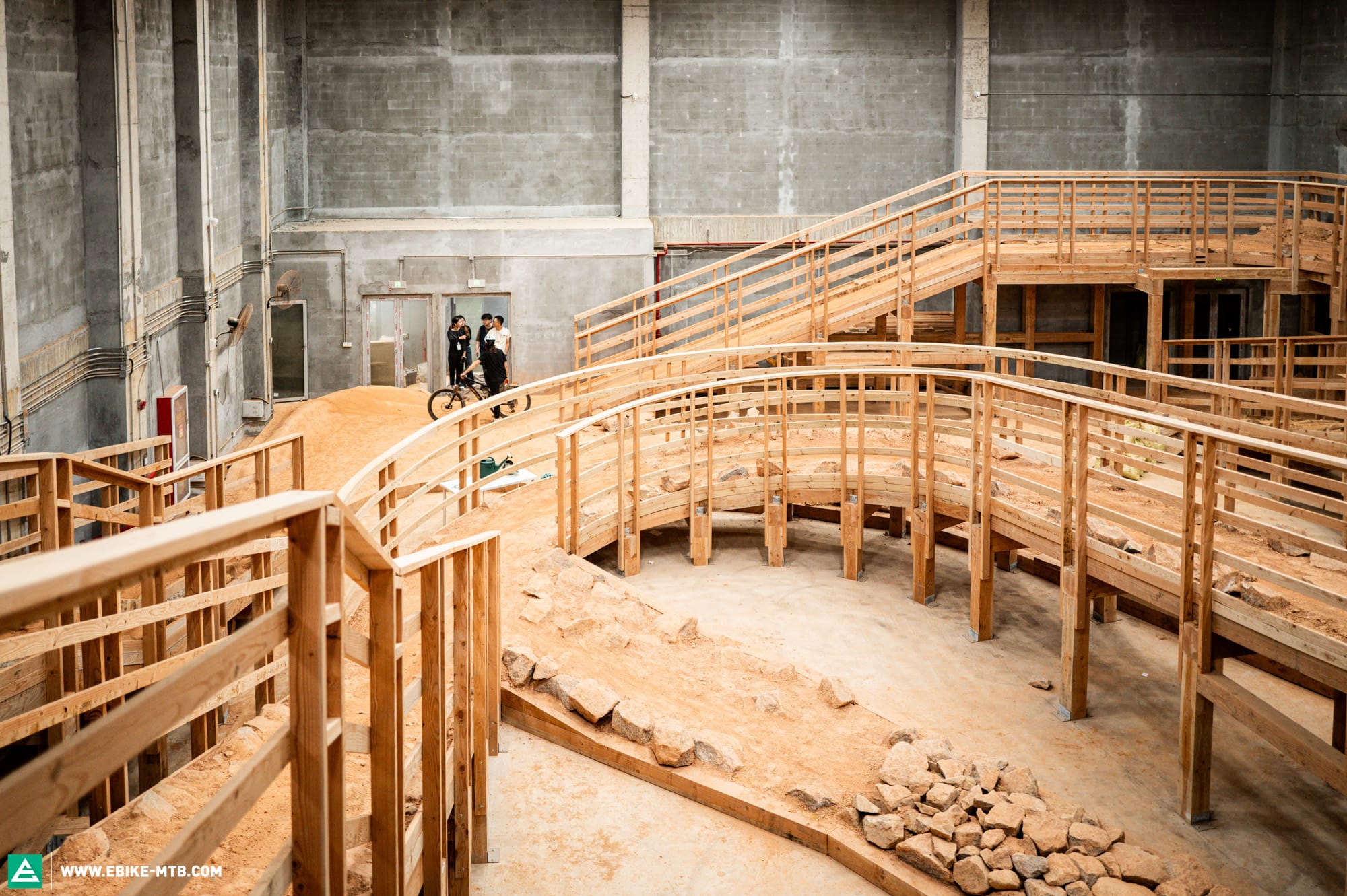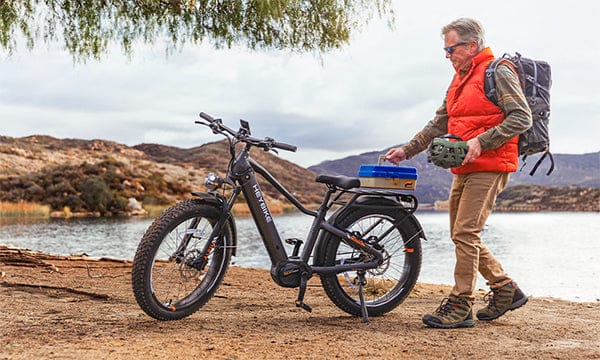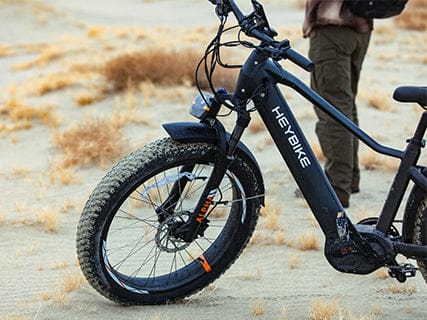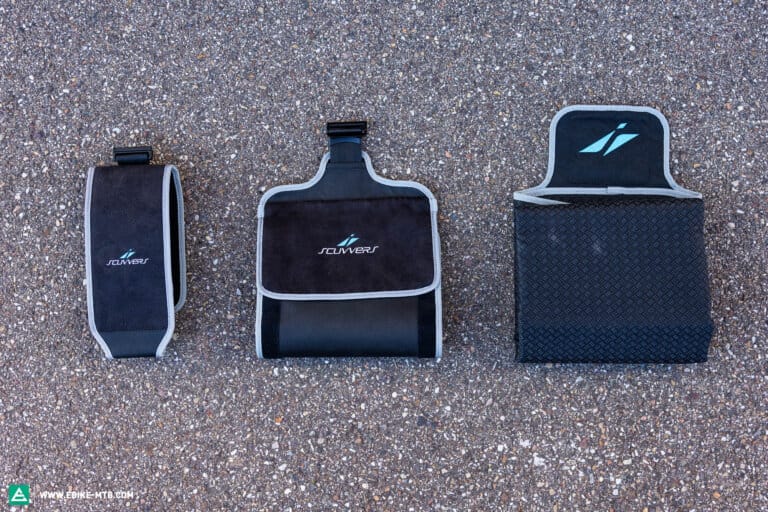DJI Avinox Drive System vs other motor systems – DJI goes eMTB
What’s behind DJI and their new Avinox Drive System? What can we expect from the drone pioneer in the future? And why will this new drive system also influence the drone development? We were the first bike magazine worldwide to visit DJI’s headquarters in Shenzhen, and had the opportunity to take a look behind the scenes.
Champagne poppin’! The DJI Avinox Drive System secured victory in our huge 2025 motor comparison test – and they totally deserved to win! After being the first bike magazine to test the motor system exclusively back in June 2024, and after benchmarking it throughout the past season, it was pretty clear: the DJI Avinox M1 it sets new standards in terms of ride quality, modulation, usability, and connectivity, overshadowing the competition in all these respects – all packed in a format that that comes dangerously close to light motor concepts, both in terms of dimensions and weight. But what’s the story behind the “new-kid-in-town amongst” eMTB motors?
To understand this, we travelled to the place where the idea originated: DJI Sky City, the company’s headquarters in Shenzhen, China. Designed by star architects Foster + Partners, the two skyscrapers can accommodate thousands of employees. From the moment you arrive, it’s clear that technological progress not only is developed here, but also lived. At the same time, the ambiance is reminiscent of Apple – perhaps due to the fact that this is the same architecture firm that designed Apple Park in Cupertino – but also due to the clean, minimalist corporate identity. Aside from a small logo at the reception, DJI’s branding is absent inside and outside the buildings. In October 2024, our magazine’s founder and editor-in-chief, Robin Schmitt, accompanied by photographer Oli Graf, were welcomed by Avinox developers, test track managers, and other colleagues.



The massive entrance area alone is impressive: A Zen-style garden is the gateway to the DJI dimension. After passing through security, big elevators take you to the upper floors, with modern workspaces opening up behind the lift doors. A floating glass bridge connects the two towers of the headquarters. DJI offers more than just workspaces for their employees. There are also a relaxation garden, a gym, and even a kindergarten, which all provide a harmonious balance in everyday life. Our absolute highlight: a traditional tea house, which transports you into another dimension and creates a serene contrast to the otherwise fast-paced environment.
Fun fact: The glass facades on the upper floors need to be curtained down because there are individuals frequently attempting to gain insights into DJI’s latest developments.
The next surprise is right next door: an indoor test track located in the adjacent shopping center. As soon as the doors open, you find yourself in a completely different world of dust, dirt, and features. It’s right here, on the in-house test track, that the DJI Avinox Drive System was developed, fine-tuned, and tested. Needless to say, we took the opportunity to thoroughly ride the system and speak directly with the developers about its features and ride feel.
As the first magazine worldwide, we were able to put the Avinox Drive System through the wringer, not only on the indoor test track in Shenzhen but also under real conditions in Germany’s central mountain ranges and the Alps.
Shenzhen as an innovation hub
The development of the DJI Avinox takes us straight to Shenzhen. The entire drive system is manufactured here, and it’s no coincidence that DJI chose this location. Often referred to as the “Silicon Valley of China,” Shenzhen is home to Chinese tech giants like BYD, as well as subsidiaries of many international companies such as Microsoft. For years, Shenzhen has been a magnet for developers and IT specialists – anyone with ambition and the drive to make an impact moves here. The pace is different, markedly faster – what takes 2-3 days in other parts of the world is completed here in just a single day. Witchcraft? Nope. Shenzhen is simply a hub for young tech developers and university graduates who are hungry and eager to accelerate their careers. The result? A work pace and level of innovation that are on another level. There’s even a term for it: “Shenzhen Time.”


DJI has called Shenzhen home since 2006. What began as a vision to make drones accessible to everyone, has grown into a global technology leader. But DJI is capable of far more than just flying cameras; powerful power stations and gimbals are also among the company’s specialties. These very technologies and experiences, initially developed for aerial photography and filmmakers, now form the foundation of the DJI Avinox Drive System. The mindset behind it is the same: to make a premium product widely accessible at high quality and in large quantities – the keyword here is economy of scale.

For us, it was the logical next step
E-mountain bikes are no longer a niche product. With a projected market value of $71.5 billion by 2030, according to Markets and Markets, the potential remains massive despite current market conditions. Particularly in Europe, where eMTBs account for over half of the market share, DJI have spotted their opportunity. No sooner said than done… For three years, behind closed doors and in complete silence, a team consisting of passionate e-mountain bikers and engineers worked on the new drive system. The result? Surprisingly impressive – or rather, outstanding. Was it a surprise, or just logical?

What sets DJI apart from the competition
The DJI Avinox Drive System may have come as a surprise to many – but its success does not, once you take a look behind the scenes at DJI.
While other motor manufacturers are scrambling to find new business sectors amidst the pressure of weakening core markets, DJI have ventured into this new field from a position of strength – with a flourishing core business to support it.
DJI is, first and foremost, a software and tech company, bringing with it a wealth of expertise: experience in motor development from drones, battery technology from power station and aerial devices, and precise software control from gimbals. On top of this, DJI benefits from an established supply chain and long-standing partnerships with suppliers, which enables them to produce high volumes at competitive prices.
However, DJI doesn’t want to stand out solely with a powerful motor. To ensure customer satisfaction, the manufacturer has developed a well-thought-out service network: a service hotline, local dealers, and a large spare parts warehouse in the Netherlands, which aims to replace defective parts within three days. Dealers even report that spare parts were already available before the first Amflow bikes were delivered. With over ten years of experience in remote support, DJI appears to be well-prepared – at least on paper. Whether the service network will live up to customer expectations in practice remains to be seen. However, the signs are promising.
Another factor that sets DJI apart is their remarkable work pace. DJI operates noticeably faster and more deftly than many established companies – something we clearly noticed in our communications with them.
What differentiates the DJI Avinox Drive System from other motor systems?
The DJI Avinox Drive System not only boasts impressive technical specifications but, above all, sets itself apart through the riding experience it delivers:
Weighing in at just 2.52 kg, the Avinox Drive System sets a new benchmark for weight. This is achieved through a compact planetary gearbox that relies on polymer gears. Not only does this reduce weight but also minimises noise development. Originally, this technology was derived from the gimbal control system of the DJI Inspire 3, a professional cinema drone for filmmakers.

DJI uses the latest LG cells for the Avinox Drive System batteries and relies on a weight-optimized design too. The 600-Wh version weighs in at just 2.9 kg, while the 800-Wh variant tips the scales at 3.7 kg. For comparison’s sake: Bosch’s PowerTube 800-Wh battery weighs 3.9 kg – which is around 200 grams more. Thanks to 12A GaN fast-charging technology, the 800-Wh battery can charge from 0 to 75% in a speedy 1.5 hours – a fraction of the conventional charging times offered by other manufacturers, which range between 4 and 6 hours.
The battery management system is also developed in-house, and is designed to improve both lifespan and efficiency. A particularly practical feature is the automatic self-discharge function. After seven days, the charge level automatically drops to 95%, and after 30 days to 60%, protecting the cells from aging and capacity loss – a concept DJI adopted from their Phantom drone series. Additionally, temperature sensors monitor the battery to prevent damage caused by extreme temperatures, regardless of whether hot or cold. Through the Avinox app, users can keep an eye on the battery charge status at all times and receive immediate notifications in case of issues.


DJI compares the battery to a muscle: only through regular use and proper care – avoiding deep discharges below 20% and not leaving the eMTB constantly charged above 80% – can you extract its maximum performance.
With 105 Nm of torque, the Avinox Drive System delivers enough power to conquer even the steepest climbs. In Boost mode, it can even provide 120 Nm for short bursts. However, torque alone isn’t enough. What truly matters is modulation – the interplay between rider input and motor output. The Avinox Drive System delivers assistance with great precision, ensuring a natural riding experience that keeps the rider in full control despite the high power output.
The difference lies in DJI’s proprietary Multi-Sensor Fusion technology. While other systems often rely on fewer and less refined sensors, the Avinox Drive System employs 10 high-precision sensors that capture data such as cadence, speed, and terrain in real time. Ferdinand Wolf, Product Experience Director at DJI, explains:
“At first glance, you’d think a drone is more complex to develop and requires more sensors. But an eMTB motor is really something else. Drones are sensitive to control inputs and external influences like wind, but an eMTB motor needs to think ahead: your pedaling cadence, current speed, the trail – everything must be interpreted and implemented in real time. For that, you need significantly more sensors.”
The most visible sensor is the speed sensor mounted on the brake rotor, which measures the rear wheel’s movement 41 times per revolution. This allows the Avinox to determine speed far more accurately than many competing systems, which measure just 1 to 18 times per rotation, as seen with systems like the Haibike XDURO Nduro 10.0. This level of precision even enables the motor to calculate which gear you’re using – even with manual drivetrains.

The collected sensor data is then analyzed by the Smart Assist Algorithm, which adjusts motor support based on riding style and terrain. In Auto Mode in particular, the algorithm takes over the work. For the rider, this means less distractions, allowing them to focus on the trail ahead.



What challenges do DJI face with the Avinox Drive System?
Currently, Bosch and Shimano are the two dominant players in the eMTB market. However, DJI brings a breath of fresh air to the sector – and a new perspective too. The question is not whether DJI will play a role in the market, but rather how quickly and how significantly that role will grow. The drone giant’s entry is visibly shaking up the industry. Customers have reason to be excited: not only about an excellent motor, but also because DJI is pushing other manufacturers to offer a new level of service and usability.
We can’t wait to show which bikes featuring the Avinox Drive System will hit the market.
Now, it’s up to bike manufacturers to embrace a system coming from an industry newcomer. DJI is addressing these concerns with fair pricing and an exceptionally strong overall package.


Top 5 – What we can expect from DJI in the future
1. New bikes with the DJI Avinox Drive System: The first spy shots, like those of Forbidden Bikes, are already circulating on social media, showing that DJI are actively collaborating with numerous bike manufacturers – including North American brands . Contrary to concerns, DJI have stated (pending any changes in U.S. policy – let’s see what Trump does!) that there are currently no usage restrictions for the U.S. market. DJI have confirmed that in 2025, additional eMTBs featuring their motor system will launch alongside the Amflow PL Carbon Pro. Which brands will be involved remains an exciting question. While most bike manufacturers will adopt the complete DJI Avinox Drive System, DJI remains open to custom battery solutions.
2. From trails to urban streets – DJI plans to conquer the urban sector with the Avinox Drive System. After all, the system’s power and modulation make it an optimal choice for urban e-bikes, particularly cargo bikes. How quickly and effectively this will happen remains to be seen – especially given that the Swabian motor manufacturer Bosch enjoys enormous trust in this specific niche, and new players often struggle to gain a foothold in the Central European market.
3. Range extender – Lower on DJI’s priority list is a range extender. The Chinese company sees limited demand for such a solution with their Avinox Drive System, and instead wants to focus on optimizing their existing systems.
4. Free software updates – Starting in 2025, free software updates will be available via the Avinox app, offering new features and improvements that can be installed in just a few minutes via Wi-Fi or 5G. Nice!
5. User-driven development – DJI stays close to their users and actively involves them in the development process – for example, through the Amflow Bike Community Official Facebook group. Here, amateur riders are recruited as test riders, beta versions are trialed, and direct feedback is collected. Not only does this allow them to build a strong community but also facilitates honest exchanges that drive further development.
6. Bonus: Which bikes would you like to see with the DJI Avinox motor system in the future?
Share your favorite brands that you’d like to see equipped with the DJI Avinox Drive System!
With the Avinox Drive System, DJI demonstrates how drone technology can enrich the e-bike industry. The system combines smart software, compact technology, and well-thought-out batteries into an impressive overall package. Is Avinox the beginning of a revolution? That remains to be seen, but DJI is undoubtedly bringing fresh momentum to the industry and pushing innovation forward. The question of which bikes will follow with this drive system remains exciting. One thing is certain: with the Avinox Drive System, DJI is bringing in new benchmarks that will bring positive changes to this industry as a whole and facilitate the market to continue thriving.

Words: Benedikt Schmidt Photos: Oliver Graf, Robin Schmitt







